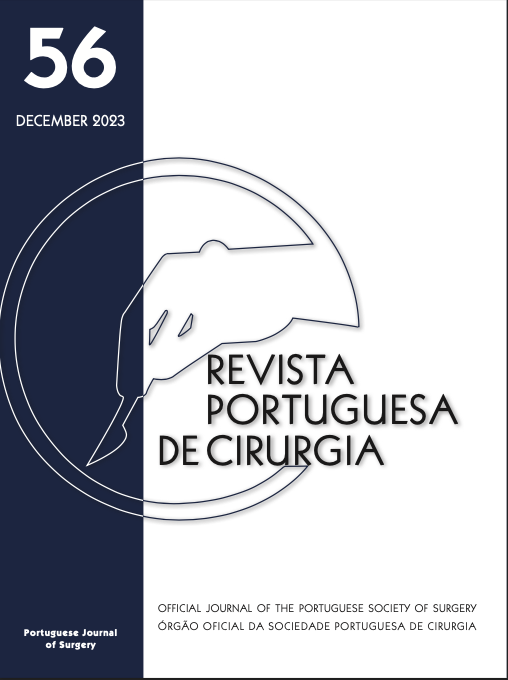AORTIC LACERATION DURING VERESS NEEDLE INSERTION: A LAPAROSCOPIC DISASTER
DOI:
https://doi.org/10.34635/rpc.929Keywords:
laparoscopy, iatrogenic disease, abdominal aortaAbstract
Introduction: Over 50% of complications related to laparoscopy occur during the entry phase for pneumoperitoneum and trocar insertion. Major vascular injuries, although infrequent (0.04–0.1% of laparoscopic procedures), can lead to significant morbidity and mortality, with 13%–50% going undetected immediately during surgery. Major vascular injuries rank as the second most common cause of death during laparoscopy, following anesthesia-related deaths, with a mortality rate of 6.37%. Immediate response to vascular injuries should prioritize assessment and potential control rather than immediate conversion to laparotomy. Recognized risk factors for entry phase injuries during laparoscopy include obesity, prior abdominal surgeries, surgical experience, inflammatory bowel disease, and pelvic inflammatory disease.Clinical case: A 47-year-old woman with a BMI of 42.2 kg/m2, no prior abdominal surgeries, and two recent episodes of diverticulitis within six months, was scheduled for an elective left hemicolectomy at a secondary hospital. During Veress needle insertion, blood was observed. Subsequently, upon placing the first trocar, a median retroperitoneal inframesogastric hematoma was identified, and attempts to control bleeding were unsuccessful, leading to conversion due to hemodynamic instability. An infrarenal aortic laceration was revealed, requiring clamping to halt bleeding. The patient was then transferred to a tertiary hospital for vascular surgery intervention, involving aortoplasty with a patch of the great saphenous vein and thrombectomy of the ilio-distal arteries. The time from injury to the start of vascular surgery was 2 hours. The patient was admitted to an Intensive Care Unit, receiving 15 red blood cell units (initial 2 without compatibility testing), 12 plasma units, 3 grams of fibrinogen, and 1 platelet pool. During the intensive care stay, the patient developed leg compartment syndrome, necessitating fasciectomy, and moderate ARDS, complicating disease management.
Conclusion: While major vascular lesions in laparoscopic surgery are rare, they are linked to significant morbidity and mortality. A collaborative effort involving laparoscopic surgeons, anesthesiologists, vascular surgeons, and intensivists is essential to minimize damage and improve vascular repair outcomes. Strict action protocols are crucial to reducing morbidity and mortality associated with major vascular injuries during laparoscopic procedures.
Downloads
References
2. L. Cravello, J. Banet, A. Agostini, F. Bretelle, V. Roger, B. Blanc, L’open-coelioscopie»: analyse des complications liées au mode
d’introduction du premier trocart. Gynécologie Obstétrique & Fertilité, 2002 3. Härkki-Sirén P, Kurki T. A nationwide analysis of laparoscopic complications. Obstet Gynecol. 1997 Jan;89(1):108-12. doi: 10.1016/s0029-7844(96)00390-0. PMID: 8990449.
4. Baadsgaard SE, Bille S, Egeblad K. Major vascular injury during gynecologic laparoscopy. Report of a case and review of published cases. Acta Obstet Gynecol Scand. 1989;68(3):283-5. doi: 10.3109/00016348909021007. PMID: 2533451.
5. Nordestgaard AG, Bodily KC, Osborne RW Jr, Buttorff JD. Major vascular injuries during laparoscopic procedures. Am J Surg. 1995 May;169(5):543-5. doi: 10.1016/s0002-9610(99)80214-1. PMID: 7747836.
6. Geers J, Holden C. Major vascular injury as a complication of laparoscopic surgery: a report of three cases and review of the literature. Am Surg. 1996 May;62(5):377-9. PMID: 8615566.
7. Munro, Malcolm. Laparoscopic access: Complications, technologies, and techniques. Current opinion in obstetrics & gynecology. 2002; 14. 365-74. 10.1097/00001703-200208000-00002.
8. Jansen FW, Kapiteyn K, Trimbos-Kemper T, Hermans J, Trimbos JB. Complications of laparoscopy: a prospective multicentre observational study. Br J Obstet Gynaecol. 1997 May;104(5):595-600. doi: 10.1111/j.1471-0528.1997.tb11539.x. PMID: 9166204.
9. Neudecker J, Sauerland S, Neugebauer E, Bergamaschi R, Bonjer HJ, Cuschieri A, et al. The European Association for Endoscopic Surgery clinical practice guideline on the pneumoperitoneum for laparoscopic surgery. Surg Endosc. 2002 Jul;16(7):1121-43. doi: 10.1007/s00464-001-9166-7. Epub 2001 May 20. PMID: 12015619.
10. Cornette B, Berrevoet F. Trocar Injuries in Laparoscopy: Techniques, Tools, and Means for Prevention. A Systematic Review of the Literature. World J Surg. 2016 Oct;40(10):2331-41. doi: 10.1007/s00268-016-3527-9. PMID: 27146054.
11. Larobina M, Nottle P. Complete evidence regarding major vascular injuries during laparoscopic access. Surg Laparosc Endosc Percutan Tech. 2005 Jun;15(3):119-23. doi: 10.1097/01.sle.0000166967.49274.ca. PMID: 15956893.
12. Sharp HT, Dodson MK, Draper ML, Watts DA, Doucette RC, Hurd WW. Complications associated with optical-access laparoscopic trocars. Obstet Gynecol. 2002 Apr;99(4):553-5. doi: 10.1016/s0029-7844(02)01656-3. PMID: 12039109.
13. Leron E, Piura B, Ohana E, Mazor M. Delayed recognition of major vascular injury during laparoscopy. Eur J Obstet Gynecol Reprod Biol. 1998 Jul;79(1):91-3. doi: 10.1016/s0301-2115(98)00020-7. PMID: 9643411.
14. Jansen FW, Kolkman W, Bakkum EA, de Kroon CD, Trimbos-Kemper TC, Trimbos JB. Complications of laparoscopy: an inquiry about closed- versus open-entry technique. Am J Obstet Gynecol. 2004 Mar;190(3):634-8. doi: 10.1016/j.ajog.2003.09.035. PMID: 15041992.
15. Hasson HM. A modified instrument and method for laparoscopy. Am J Obstet Gynecol. 1971 Jul 15;110(6):886-7. doi: 10.1016/0002-9378(71)90593-x. PMID: 4254516.
Downloads
Published
Issue
Section
License
Para permitir ao editor a disseminação do trabalho do(s) autor(es) na sua máxima extensão, o(s) autor(es) deverá(ão) assinar uma Declaração de Cedência dos Direitos de Propriedade (Copyright). O acordo de transferência, (Transfer Agreement), transfere a propriedade do artigo do(s) autor(es) para a Sociedade Portuguesa de Cirurgia.
Se o artigo contiver extractos (incluindo ilustrações) de, ou for baseado no todo ou em parte em outros trabalhos com copyright (incluindo, para evitar dúvidas, material de fontes online ou de intranet), o(s) autor(es) tem(êm) de obter, dos proprietários dos respectivos copyrights, autorização escrita para reprodução desses extractos do(s) artigo(s) em todos os territórios e edições e em todos os meios de expressão e línguas. Todas os formulários de autorização devem ser fornecidos aos editores quando da entrega do artigo.



